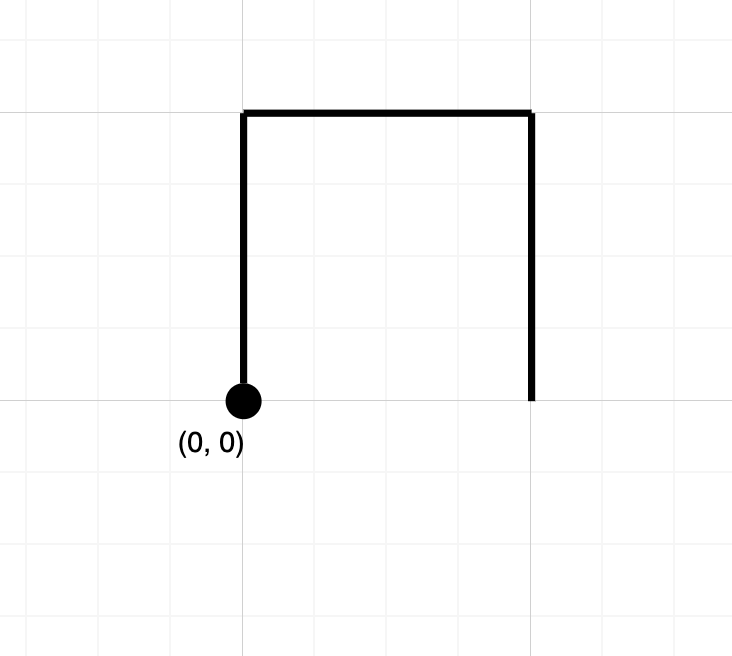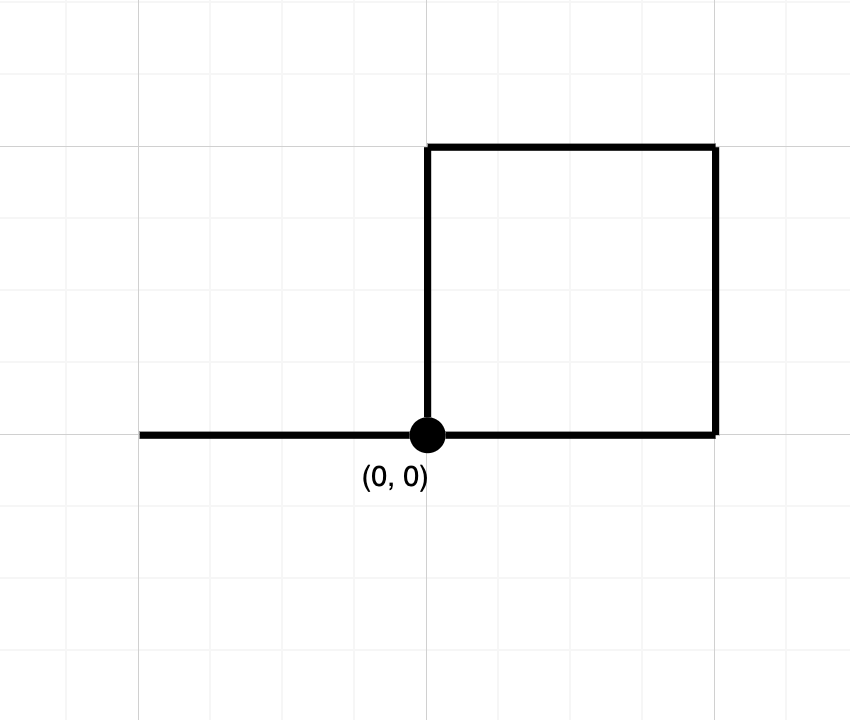英文原文
Given a string path, where path[i] = 'N', 'S', 'E' or 'W', each representing moving one unit north, south, east, or west, respectively. You start at the origin (0, 0) on a 2D plane and walk on the path specified by path.
Return true if the path crosses itself at any point, that is, if at any time you are on a location you have previously visited. Return false otherwise.
Example 1:

Input: path = "NES" Output: false Explanation: Notice that the path doesn't cross any point more than once.
Example 2:

Input: path = "NESWW" Output: true Explanation: Notice that the path visits the origin twice.
Constraints:
1 <= path.length <= 104path[i]is either'N','S','E', or'W'.
中文题目
给你一个字符串 path,其中 path[i] 的值可以是 'N'、'S'、'E' 或者 'W',分别表示向北、向南、向东、向西移动一个单位。
机器人从二维平面上的原点 (0, 0) 处开始出发,按 path 所指示的路径行走。
如果路径在任何位置上出现相交的情况,也就是走到之前已经走过的位置,请返回 True ;否则,返回 False 。
示例 1:

输入:path = "NES" 输出:false 解释:该路径没有在任何位置相交。
示例 2:

输入:path = "NESWW" 输出:true 解释:该路径经过原点两次。
提示:
1 <= path.length <= 10^4path仅由{'N', 'S', 'E', 'W}中的字符组成
通过代码
高赞题解
方法一:哈希表
思路
我们可以模拟机器人行走的过程,机器人行走的本质是它的坐标发生了变化,要解决这个问题,就要保存机器人走过的所有坐标——所以这道题的关键在于如何判断「走到之前已经走过的位置」。
由于数组 $\it path$ 的长度最大是 $10^4$,我们并不能开一个二维数组来表示这个坐标平面:在极端情况下,机器人每次都沿着同一个方向前进,开二维数组需要 $(10^4)^2$ 个布尔类型变量的空间,它非常大。实际上,这 $(10^4)^2$ 个位置并不是都能用到,大多数位置是没有访问到的,用这样的方法打访问标记会造成很大的空间浪费。
因此我们可以用哈希表来解决这个问题,即我们可以给「已经走过」的位置打上访问标记,把坐标 $(x, y)$ 存入哈希表,每次模拟坐标的变化得到新的坐标,在哈希表中查询这个坐标对应的哈希值有没有出现过,这样既不用花费很大的空间,又能快速查询到一个坐标是否访问过。
在 C++ 语言中,如果使用 pair<int, int> 存储坐标,那么我们需要自己实现哈希映射函数。我们可以令哈希函数 $f(x, y) = x \times 20001 + y$,这是因为 $y$ 的取值范围在 $[-10^4, 10^4]$ 内,共有 $20001$ 种可能性,上述的哈希函数就不会造成冲突。在 Python 语言中,我们使用元组 tuple 存储坐标,可以直接放入哈希表 set 中。
代码如下。
代码
[sol1-C++]class Solution { public: int getHash(int x, int y) { return x * 20001 + y; } bool isPathCrossing(string path) { unordered_set<int> vis; int x = 0, y = 0; vis.insert(getHash(x, y)); for (char dir: path) { switch (dir) { case 'N': --x; break; case 'S': ++x; break; case 'W': --y; break; case 'E': ++y; break; } int hashValue = getHash(x, y); if (vis.find(hashValue) != vis.end()) { return true; } else { vis.insert(hashValue); } } return false; } };
[sol1-C++11]class Solution { public: bool isPathCrossing(string path) { auto pairHash = [](const pair<int, int>& o) { return o.first * 20001 + o.second; }; unordered_set<pair<int, int>, decltype(pairHash)> vis(0, pairHash); int x = 0, y = 0; vis.emplace(x, y); for (char dir: path) { switch (dir) { case 'N': --x; break; case 'S': ++x; break; case 'W': --y; break; case 'E': ++y; break; } if (vis.find({x, y}) != vis.end()) { return true; } else { vis.emplace(x, y); } } return false; } };
[sol1-Java]class Solution { public boolean isPathCrossing(String path) { Set<Integer> vis = new HashSet<Integer>(); int x = 0, y = 0; vis.add(getHash(x, y)); int length = path.length(); for (int i = 0; i < length; i++) { char dir = path.charAt(i); switch (dir) { case 'N': --x; break; case 'S': ++x; break; case 'W': --y; break; case 'E': ++y; break; } int hashValue = getHash(x, y); if (!vis.add(hashValue)) { return true; } } return false; } public int getHash(int x, int y) { return x * 20001 + y; } }
[sol1-Python3]class Solution: def isPathCrossing(self, path: str) -> bool: dirs = { "N": (-1, 0), "S": (1, 0), "W": (0, -1), "E": (0, 1), } x, y = 0, 0 vis = set([(x, y)]) for ch in path: dx, dy = dirs[ch] x, y = x + dx, y + dy if (x, y) in vis: return True vis.add((x, y)) return False
复杂度
假设 path 的长度为 $n$。
时间复杂度:$O(n)$。最坏情况下,对于 $n$ 个元素,每个元素做一次 $O(1)$ 的哈希表查询和一次 $O(1)$ 的哈希表插入。
空间复杂度:$O(n)$。这里使用了哈希表作为辅助空间,故空间代价是 $O(n)$。
统计信息
| 通过次数 | 提交次数 | AC比率 |
|---|---|---|
| 11471 | 21384 | 53.6% |
提交历史
| 提交时间 | 提交结果 | 执行时间 | 内存消耗 | 语言 |
|---|




